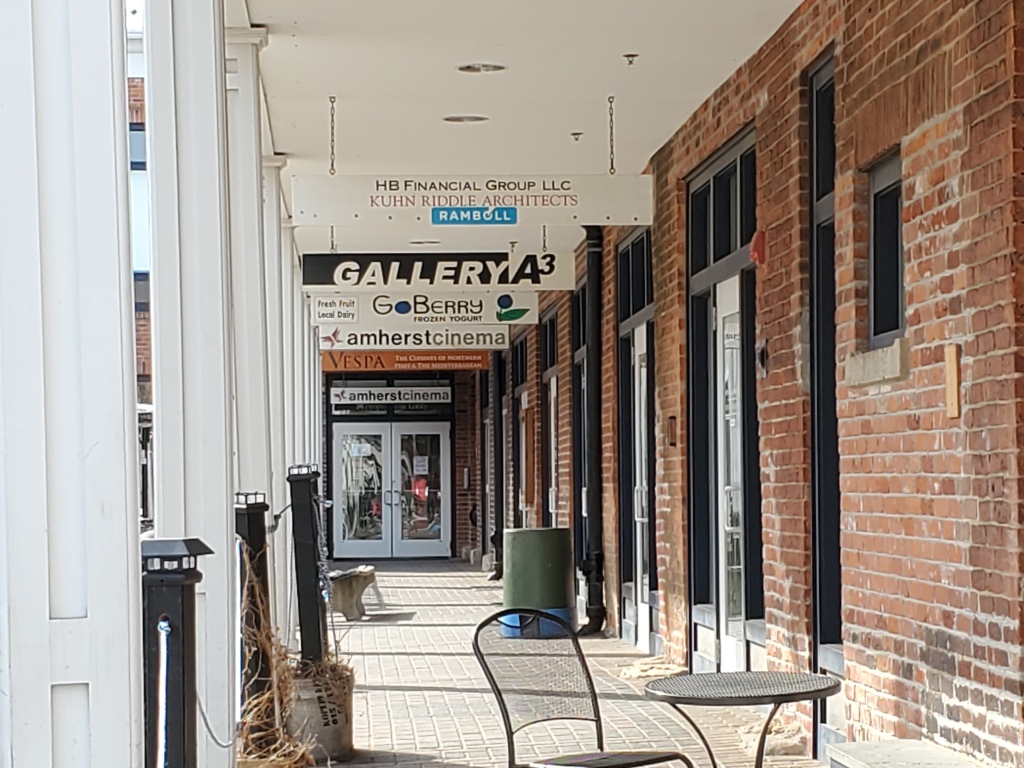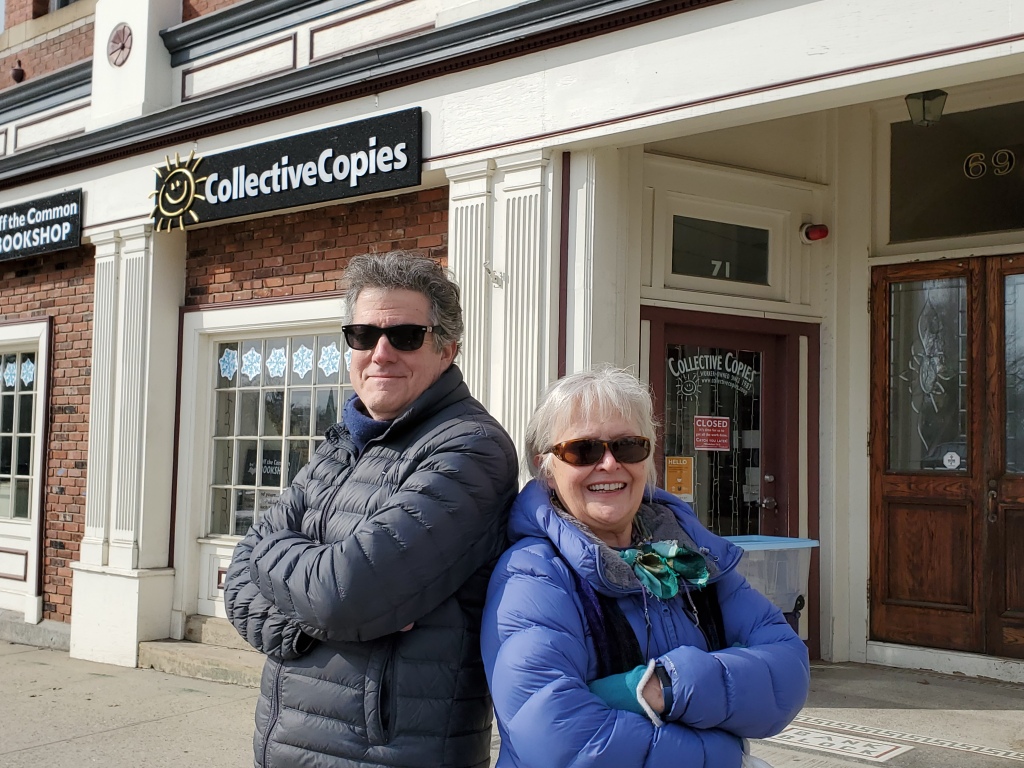By Andy Churchill and Meg Gage
Andy: In our last column, we talked about how downtown has evolved over the years and that further development should be done in a way that supports vibrancy and increases tax revenues. And we talked about the idea of using design standards, technically known as “form-based code,” to guide the look and feel of future development.
This time, let’s get more specific. Let’s take our readers on a virtual walk downtown and think about future design standards. What aspects do we like, and want to see more of? What elements would we prefer never to see again?
Meg: Okay, I’ll play. Do you want to go first?

Andy: I would say my favorite block downtown is the stretch with Fresh Side, Hastings, and Collective Copies, west of the Common. Those buildings have retail on the ground floor and offices and apartments upstairs. And some of them are four stories tall, but they have design features that make them attractive and not overwhelming. I could go for more of that style downtown.
Meg: I agree. As you might expect, one of my favorite downtown spots is the Amherst Cinema building that combines an independent film house with a number of successful, small businesses as well as a small art gallery. Imagine a successful business that sells frozen yogurt year-round with milk from local cows! Small businesses can succeed if they have the appropriate infrastructure support – like plumbing, electricity, and walls – rather than cavernous undeveloped space. Thanks to Barry Roberts for partnering with the Amherst Cinema to make that happen. And thanks to the Amherst Cinema for investing in a rigorous business plan before any renovations happened. Again, planning!!
In terms of the appearance of downtown blocks, I like the block between Subway and Formosa, where the Lincoln Building is. This stretch combines old and new buildings but with a somewhat unified style and (my favorite) a very wide sidewalk. Hooray for wide sidewalks!
Andy: As for negative aspects, I am puzzled by the way the North Pleasant “skyline” suddenly drops off around Antonio’s, and we go from multi-story, mixed-use buildings to a series of old family homes pressed into service as businesses. Those seem like prime targets for redevelopment, along with the single-story CVS and Zanna buildings – just continue the multi-story line down the street, so more people can live and work downtown. But do it with some style – not like the bland, soulless brick building next to the fire station, where The Works is.

Meg: Don’t forget the most hideous building in town or perhaps in the Valley: The Bank of America building that is 45 degrees out of whack with every other building in town, has those horrific square columns with no structural or artistic purpose, the outrageous useless space that has to be heated and cooled – and the bizarre gerbil run on the second floor! That is one building everyone agrees is a downtown catastrophe!
Andy: Ugh. Yes.
Meg: I think a redesigned building there would make a fabulous Thorne’s Market-style venue with 2–3 floors of small boutiques and some carefully planned, financially sustainable arts space on the top floor. Maybe film-making courses sponsored by Amherst Cinema, and/or rehearsal space for the black box theater we can create in the old fire station! I am convinced, as I said earlier, that we could attract more small businesses if more infrastructure – plumbing heating, electricity – were provided. Maybe it could be “Roberts’ Market”! The Bank of America could sell it and consolidate their business at the Triangle Street mini bank. I know what you’re thinking: “Dream on, Meg!”
Andy: Well, while we’re dreaming, how about an easily accessible parking garage with plenty of space for all the people using “Roberts’ Market” and all the other current and future attractions downtown?

Meg: Sure, a parking garage based on a plan so it’s the right size, in the best location and structured so it’s public parking and not parking primarily for student renters. A private parking lot makes me nervous! A topic for the future we probably won’t agree on! I fear the editors of the Amherst Current were hoping we might have more fireworks than we did this time around, so that sounds like a great topic for next time. Ka-boom!
Andy: Haha! You crack me up. So much to argue about; so little time!
Meg: You know, Andy, I think we could agree on the importance of planning and perhaps also on the components of a good plan.
Andy: Yes, planning is good. Good planning is even better! Where would you start?

Meg: Well, I would start with goals or what some call a “vision.” What do we want? I am a big fan of quite specific goals and sometimes find the concept of “vision” to result in vagueness, but having a vision of what we want is also important. And that vision can be translated into goals. I think our Master Plan lays out a lot of that.
Andy: Having been part of the Master Planning process, it always warms my heart when it gets referenced. It really was a substantial public outreach project – more than 1,000 residents provided input back in 2006-10, and in 2020 it was reviewed and adopted by our Town Council. I think you’re right that it provides a broad vision – and that we need a more specific plan for our downtown.
Meg: When I think about the components of a good plan, whether it’s about our downtown or about building a house or about creating a strong organization, there are some crucial requirements. I would roughly summarize them as:
- Setting goals based on a vision
- Clarity about values
- Establishing the exact need
- Evaluating options for meeting the need including size, location, who is served, etc.
- Creating a business plan – reviewing research and other information about viability, cost of building, operating budget, etc.
- Getting input from everyone who will be affected while there are still options from which to choose.

Andy: Those sound like good components of a planning process. To get even more specific about the future look and feel of the downtown, I think we should revisit Amherst’s previous attempt to establish form-based code. To quote from the Form-Based Code Institute’s website:
Form-based codes address the relationship between building facades and the public realm, the form and mass of buildings in relation to one another, and the scale and types of streets and blocks. The regulations and standards in form-based codes are presented in both words and clearly drawn diagrams and other visuals… This approach contrasts with conventional zoning’s focus on the micromanagement and segregation of land uses, and the control of development intensity through abstract and uncoordinated parameters…
Amherst already has a form-based code proposal drafted; it was presented to Town Meeting a few years ago. Maybe the Town Council could ask the Planning Board to hold some hearings on that draft and see if we can get an updated version approved that will reflect the will of the community and put some rules in place to guide development going forward.
Meg: That would be a good first step – well-advertised public hearings about relevant topics is almost always a good idea! I confess needing to relearn about form-based design before I jump in as gung-ho advocate. I will do that before we reconvene!


It’s great to read this dialogue, even if purported adversaries are generally in agreement with each other. Yes: demolish the Bank of America building! I love Meg’s ideas for a multipurpose, Thorne’s market-style building to replace it. I would really like to see Barry Roberts take down his dilapidated property just north of CVS (once the beloved Miss Saigon and other small businesses have had a chance to relocate) and replace it with a full-service co-op supermarket with apartments/offices above it. To my mind, a downtown with a supermarket is a must, especially one that has space for people to enjoy serendipitous encounters with one another. And it should be obvious that a co-op supermarket is best at providing those opportunities. Just imagine Greenfield without Greenfields Market co-op!
LikeLike
Either these conversations are the beginning of a new era in intertribal amity, a turning the corner, so to speak, or these conversations are just not capturing the real level of deep conflict on downtown development we have in town.
LikeLike
Form-based – with a respect for historical style – would be a great way to go; as Meg might say, “Planning…!” rather than piecemeal. Many/most municipalities grow piecemeal and look it. You can love or hate NYC, for example, in this regard. Take a look at Dubai’s form-based approach, scale it down just a smidgeon for Amherst 😉 and let’s go.
As for BOA, with an appreciative hat-tip to Vince Cleary, it is indeed a blot on the escutcheon.
Tom Porter
LikeLike
All skepticism aside, I want the town that is reflected in the mere fact that these conversations took place. Andy and Meg, a community turns its lonely eyes to you.
LikeLike
From Robert Greeney:
Great. Let’s work together to achieve what we all want. I would like to see the Planning Board set aside a substantial amount of their time for inclusive and participatory community wide planning. A nine member board, as in the past, would be better than the new, current seven member board. The Board must be populated with diverse and dissenting voices that dialogue in a visionary manner as modeled here with Meg and Andy. How about a Master Plan Implementation Committee (MPIC) as specified in the master Plan.
However, to really launch a “new age” of creativity and development, we, as a community, need to stop relying solely upon the energy of private profit making entities to realize our collective vision of community. Our current system is profoundly biased in favor of private ownership and profit making. Over $200, 000, 000 annually is spent on student housing alone in our area. That is a huge local resource of wealth that we are not harnessing for our collective social wellbeing. It is so obvious that our current system leads to greater and greater inequities and the inappropriate accumulation of money and power. Is it too visionary to contemplate fundamental change? I think not. I do believe the answer lies in our collective will and wisdom. Let’s unite, talk to each other, and try. Why not?
LikeLike
[…] Editor’s note: The article A Civil Conservation Part 3 appeared originally in The Amherst Current on March 14, 2022. It is reposted here with the permission of the authors and […]
LikeLike
[…] the latest edition of their feature a Civil Conversation (Part 3), Andy Churchill and Meg Gage discuss the perceived benefits of form-based code as a possible […]
LikeLike